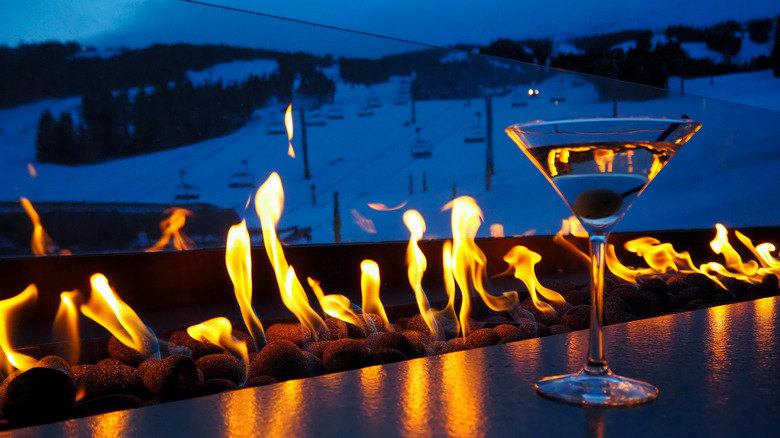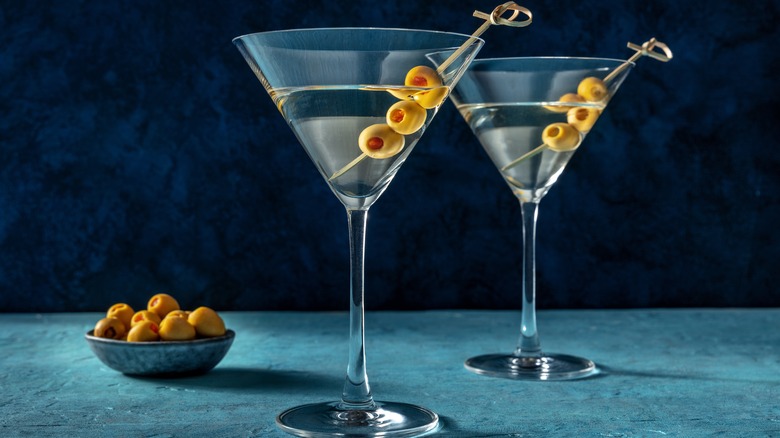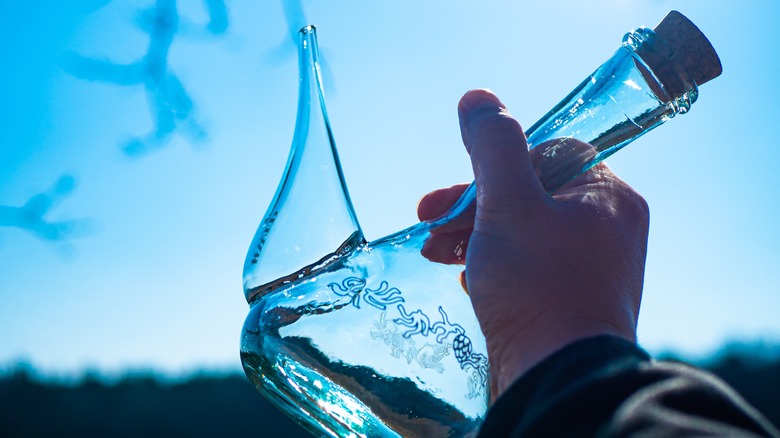The 'Tree Martini' That Got Its Start On A Treacherous Ski Slope
After a few martinis, you might catch yourself wishing that they grew on trees. As the legend goes, there is one ski resort in New Mexico where that wish can become reality.
According to Punch, Taos Ski Valley owner Ernst Hermann Bloch (aka Ernie Blake) started a tradition of hiding martinis in certain trees around the ski resort. Blake says that this tradition was born in the '50s when he was giving a personal ski lesson. His student became intimidated by the poor light and steep hills, and she eventually refused to continue down the mountain.
In response, Blake asked his son to run down to his home, and have his wife mix up a martini. He stated that he was going to conduct a "medical experiment." Blake's son brought him a Spanish Porrón filled with a gin martini and olives, which Blake instructed his student to drink. He claims that her nerves were calmed, and her performance improved. Evidently, the trio made their way off their mountain.
Atlas Obscura claims that Blake then decided to continue hiding porrón martinis throughout the mountain, and by 1980, there were four documented "Martini Trees" on the mountain. It seems that this tradition was phased out after the resort came under new ownership, but the story is fanciful enough that the legend lives on in other ways. In fact, it was still influential enough to inspire the name of the Martini Tree Bar in Taos.
Tree martinis can loosen the nerves
According to Atlas Obscura, this tradition still manages to live on in a new form. At the end of a week-long ski intensive at the resort, students are brought into the woods where a small locked box is screwed to a tree. Inside is a porrón filled with a martini, and instructors and students alike share a drink. Punch adds that while skiing and drinking are two pastimes that are commonly enjoyed together, having such an open relationship between the two was ultimately a liability worry for the resort.
Healthline points out that alcohol has been proven to reduce feelings of stress and anxiety in the short term. As the legend suggests, if you're feeling weak at the knees as you stare down a black diamond, a sip of a martini might be just the thing to grant you a bit of liquid luck. Of course, the dangers of mixing such activities are also obvious. As any good skier knows, it's important to maintain your wits about you when traversing the snow, something that can be heavily complicated by imbibing. Additionally, over time, alcohol consumption has also been linked to an overall increase in frequent stress and anxiety.
The Cleveland Clinic also says that drinking alcohol in cold weather conditions is also dangerous. This is because it provides a false sense of warmth, but ultimately increases the likelihood of suffering from dehydration and pneumonia. Interestingly, another special anecdote related to this story focuses on the very specific container in which Ernie Blake stored the alcohol.
A unique vessel for a unique tradition
One question that comes to mind when hearing this story is "why the porrón?" Thirsty explains that porróns are a type of Spanish wine vessel that allows drinkers to pour a steady stream from the mouth of the pitcher to their own. This makes it a handy way to share a bottle of Spanish red with friends without glasses or sharing germs.
Even in a video where Ernie Blake explains the origins of the tradition himself, he never mentions why his wife sent this particular vessel though. He does go on to explain that he bought four more porróns that were handmade in Juarez, Mexico for their beautiful shape, but that's all the more explanation given. Punch points out that the habit of guzzling cocktails in the drinking vessel has become common among modern bartenders, but not many opt for a drink as strong as a dry gin martini.
Whatever the reason that Blake chose the porrón though, it is a fitting vessel for the "martini trees." Of course, it takes a certain amount of insider knowledge to use the container properly, something that fits right in with the secretive nature of the martini trees.


